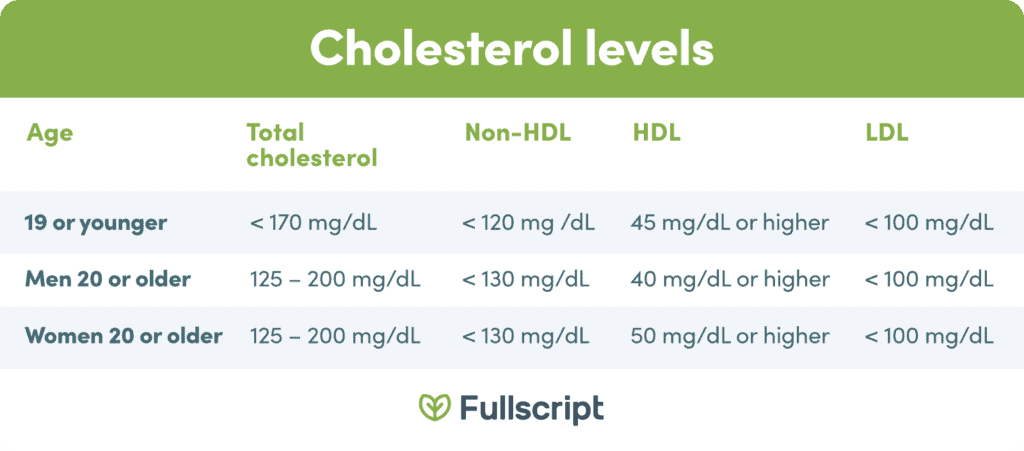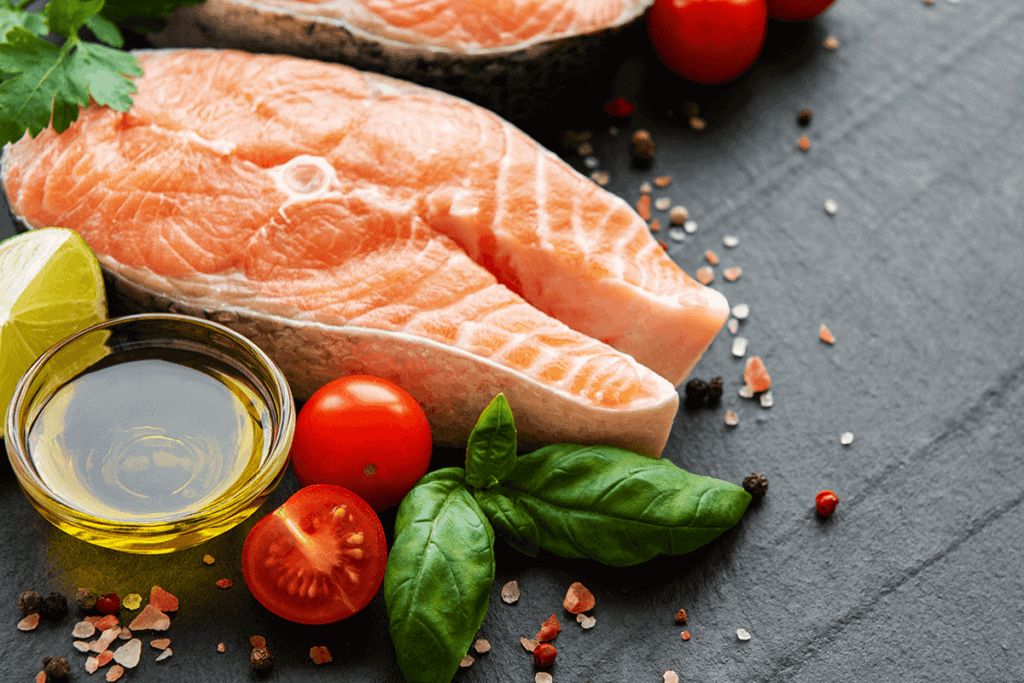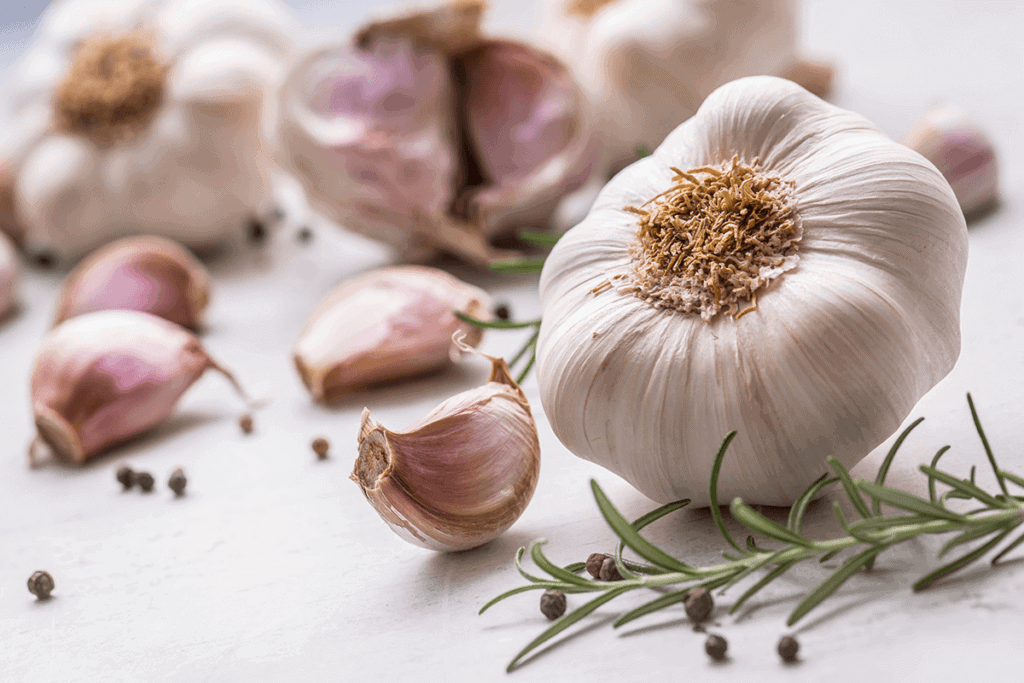What is cholesterol?
Cholesterol is a small lipid-type molecule in the blood that has important implications for heart health. It plays a part in maintaining cell membrane structure, producing bile acids, and synthesizing steroid hormones. (2) Cholesterol can be obtained through the diet from animal foods but is also produced within the body by the liver. (38) Types of cholesterol include:- High-density lipoprotein (HDL) cholesterol – responsible for transporting cholesterol from tissues to the liver to be metabolized; commonly referred to as “good cholesterol”
- Low-density lipoprotein (LDL) cholesterol – responsible for transporting cholesterol from the liver to cells throughout the body; commonly referred to as “bad cholesterol”
- Triglycerides (TG) – contain glycerol and three fatty acids; enable the transfer and storage of fat in adipocytes (fat cells)
- Very low-density lipoprotein (VLDL) cholesterol – function as a carrier molecule of triglycerides (12)

What causes high cholesterol?
The causes and risk factors for high cholesterol levels include:- Certain medications, such as diuretics and steroids
- Diabetes
- Heredity (familial hypercholesterolemia)
- High dietary intake of saturated or trans fats
- Overweight or obesity
- Sedentary lifestyle
- Smoking or second-hand smoke exposure (3)(25)

Signs, symptoms, and complications
Hypercholesterolemia doesn’t present with any clinical symptoms. It is commonly diagnosed using a lipid panel to detect elevated levels of cholesterol in the blood. High blood lipids can lead to atherosclerosis, where plaque deposits form in blood vessels, (21) which may result in serious health complications. The American College of Cardiology has developed a risk estimator for Atherosclerotic Cardiovascular Disease (ASCVD) in primary prevention patients. Complications of hypercholesterolemia include:- Coronary heart disease
- Heart attack
- Peripheral vascular disease
- Stroke (21)
Ingredients for cholesterol support
Reducing LDL cholesterol levels reduces the risk of cardiovascular events and cardiovascular disease mortality. This risk reduction was found to be greater in patients with a higher baseline risk for cardiovascular disease. (9)(11) Cholesterol levels can be managed with dietary and lifestyle modification, as well as supplementing with specific natural ingredients. (7)(17)Red yeast rice (Monascus purpureus)
Red yeast rice is made by fermenting white rice with Monascus purpureus, a type of yeast. (6) It has been used in Chinese culture as a food preservative, flavoring, and coloring agent. It is also used as a dietary supplement to treat hypercholesterolemia. (6) The active components in red yeast rice are known as monacolins, which have similar lipid-lowering effects to lovastatin and simvastatin, two commonly prescribed statin medications. (6)(22)(27) Red yeast rice has been shown to lower blood pressure, as well as LDL, total cholesterol, and homocysteine levels. (29)(14)(22)(23) Red yeast rice has also been found to induce anti-inflammatory effects. (29) Note: Listing the dosage of Monacolin K (lovastatin) on the product label is currently not required, so exact dosages may vary.Coenzyme Q10 (CoQ10)
Coenzyme Q10 is a fat-soluble compound found in the body’s heart, kidneys, liver, and pancreas. (24) CoQ10 reduces lipid oxidation in cells, (26) and acts as a gene modulator (15) and a cofactor in the mitochondrial electron transport system. (41) A meta-analysis found that CoQ10 supplementation lowers levels of the inflammatory mediators C-reactive protein (CRP), interleukin-6 (IL-6), and tumor necrosis factor-α (TNF-α). (13) Adding CoQ10 as an adjunct to statin treatment has been shown to improve cardiovascular parameters, such as triglycerides, total cholesterol, LDL, and HDL cholesterol, as well as reduce the intensity of statin-induced side effects. (34)(18)(37)Omega-3 fatty acids
Demonstrated to provide anti-inflammatory benefits, omega-3 fatty acids, including eicosapentaenoic acid (EPA) and docosahexaenoic acid (DHA), are polyunsaturated long-chain fatty acids that form part of cell membranes. (8) High amounts of EPA and DHA are found in fish oil, the primary source of these fats in the diet. (10) Fish oil supplements are commonly manufactured from krill oil, fish oil (e.g. anchovy, sardine, mackerel, etc.), and cod liver oil. Research has demonstrated that omega-3 supplements are effective in the treatment of rheumatoid arthritis (RA), osteoarthritis (OA), depression, and coronary heart disease. (1)(5)(32) Research has shown EPA and DHA to be effective in lowering fasting circulating triglyceride levels by reducing production of VLDL. (28) DHA has been shown to have a greater impact on improving HDL and decreasing triglycerides than EPA. (16)
Garlic (Allium sativa)
Garlic has a long history of culinary and medicinal uses. Garlic is a member of the allium family of plants, which also includes onions, leeks, and chives. (4) It contains sulfur compounds, such as allicin, which provides its antimicrobial, antioxidant, hypoglycemic, and hypolipidemic effects. (20) Garlic supplements have been found to be effective in reducing total cholesterol (TC), LDL, blood pressure in hypertensive patients, and C-reactive protein (CRP), a biomarker of inflammation. (39)(30)(31)(33)(35)(36) Additionally, garlic supplements have been shown to increase HDL levels. (19)
The bottom line
The prevention and management of hypercholesterolemia helps to reduce the risk of cardiovascular disease in patients. A protocol using natural supplements can be used therapeutically on its own or as an adjunct to existing treatment. If you’re a patient, we recommend speaking with your healthcare provider to find out if these supplements are right for your wellness plan. If you’re a practitioner, view our cholesterol support protocol.- Akbar, U., Yang, M., Kurian, D., & Mohan, C. (2017). Omega-3 fatty acids in rheumatic diseases. Journal of Clinical Rheumatology, 23(6), 330-339.
- Albuquerque, H. M. T., Santos, C. M. M., & Silva, A. M. S. (2019). Cholesterol-based compounds: Recent advances in synthesis and applications. Molecules, 24(1), 116.
- American Heart Association. Causes of High Cholesterol. Retrieved from https://www.heart.org/en/health-topics/cholesterol/causes-of-high-cholesterol
- Bianchini, F., & Vainio, H. (2001). Allium vegetables and organosulfur compounds: Do they help prevent cancer? Environmental health perspectives, 109(9), 893–902.
- Burhani, M. D., & Rasenick, M. M. (2017). Fish oil and depression: The skinny on fats. Journal of integrative neuroscience, 16(s1), S115–S124.
- Burke, F. M. (2015). Red yeast rice for the treatment of dyslipidemia. Current Atherosclerosis Reports, 17(4), 495.
- Butowski, P. F., & Winder, A. F. (1998). Usual care dietary practice, achievement and implications for medication in the management of hypercholesterolaemia. Data from the U.K. Lipid Clinics Programme. European Heart Journal, 19(9), 1328-33.
- Calder P. C. (2013). Omega-3 polyunsaturated fatty acids and inflammatory processes: Nutrition or pharmacology?. British journal of clinical pharmacology, 75(3), 645–662.
- Cholesterol Treatment Trialists’ (CTT) Collaborators, Mihaylova, B., Emberson, J., Blackwell, L., Keech, A., Simes, J., … Baigent, C. (2012). The effects of lowering LDL cholesterol with statin therapy in people at low risk of vascular disease: meta-analysis of individual data from 27 randomised trials. Lancet, 380(9841), 581–590.
- Cholewski, M., Tomczykowa, M., & Tomczyk, M. (2018). A comprehensive review of chemistry, sources and bioavailability of omega-3 fatty acids. Nutrients, 10(11), 1662.
- Chou, R., Dana, T., Blazina, I., Daeges, M., & Jeanne, T. L. (2016). Statins for prevention of cardiovascular disease in adults: Evidence report and systematic review for the US Preventive Services Task Force. Journal of the American Medical Association, 316(19), 2008-2024.
- Cox, R. A., & Garcia-Palmieri, M. R. (1990). Cholesterol, triglycerides, and associated lipoproteins. In H. K. Walker, W. D. Hall, & J. W Hurst (Eds.), Clinical methods: The history, physical, and laboratory examinations. (3rd ed.). Retrieved from https://www.ncbi.nlm.nih.gov/books/NBK351/.
- Fan, L., Feng, Y., Chen, G., Qin, L., Fu, C., & Chen, L. (2017). Effects of coenzyme Q10 supplementation on inflammatory markers: A systematic review and meta-analysis of randomized controlled trials. Pharmacological Research, 119, 128-136.
- Gerards, M. C., Terlou, R. J., Yu, H., Koks, C., & Gerdes, V. (2015). Traditional Chinese lipid-lowering agent red yeast rice results in significant LDL reduction but safety is uncertain – A systematic review and meta-analysis. Atherosclerosis, 240(2), 415-423.
- Groneberg, D. A., Kindermann, B., Althammer, M., Klapper, M., Vormann, J., Littarru, G. P., & Döring, F. (2005). Coenzyme Q10 affects expression of genes involved in cell signalling, metabolism and transport in human CaCo-2 cells. The International Journal of Biochemistry & Cell Biology, 37(6), 1208-1218.
- Innes, J. K., & Calder, P. C. (2018). The differential effects of eicosapentaenoic acid and docosahexaenoic acid on cardiometabolic risk factors: A systematic review. International journal of molecular sciences, 19(2), 532.
- Jenkins, D. J., Kendall, C. W., Marchie, A., Faulkner, D. A., Wong, J. M., De Souza, R., … Connelly, P. W. (2003). Effects of a dietary portfolio of cholesterol-lowering foods vs lovastatin on serum lipids and c-reactive protein. Journal of the American Medical Association, 290(4), 502.
- Jorat, M. V., Tabrizi, R., Mirhosseini, N., Lankarani, K. B., Akbari, M., Heydari, S. T., … Asemi, Z. (2018). The effects of coenzyme Q10 supplementation on lipid profiles among patients with coronary artery disease: A systematic review and meta-analysis of randomized controlled trials. Lipids in health and disease, 17(1), 230.
- Jung, E., Park, S., Choi, E., Ryu, B., Park, B., Kim, D., . . . Chae, S. (2014). Reduction of blood lipid parameters by a 12-wk supplementation of aged black garlic: A randomized controlled trial. Nutrition, 30(9), 1034-1039.
- Lawson, L. D. (1998). Garlic: A review of its medicinal effects and indicated active compounds. In L. D. Lawson & R. Bauer (Eds.), Phytomedicines of Europe. Retrieved from https://pubs.acs.org/doi/abs/10.1021/bk-1998-0691.ch014
- Linton, M. F., Yancey, P. G., Davies, S. S., Jerome, W. G., Linton, E. F., Song, W. L., … Vickers, K. C. (2019). The role of lipids and lipoproteins in atherosclerosis. In K. R. Feingold, B. Anawalt, & A. Boyce (Eds.), Endotext. Retrieved from https://www.ncbi.nlm.nih.gov/books/NBK343489/
- Liu, J., Zhang, J., Shi, Y., Grimsgaard, S., Alraek, T., & Fønnebø, V. (2006). Chinese red yeast rice (Monascus purpureus) for primary hyperlipidemia: A meta-analysis of randomized controlled trials. Chinese Medical Journal, 1, 4.
- Mazza, A., Lenti, S., Schiavon, L., Di Giacomo, E., Tomasi, M., Manunta, R., … Rubello, D. (2018). Effect of Monacolin K and COQ10 supplementation in hypertensive and hypercholesterolemic subjects with metabolic syndrome. Biomedicine & Pharmacotherapy, 105, 992-996.
- National Center for Complementary and Integrative Health. (2019). Coenzyme Q10. Retrieved from https://nccih.nih.gov/health/coq10
- National Heart, Lung, and Blood Institute. High blood cholesterol. Retrieved from https://www.nhlbi.nih.gov/health-topics/high-blood-cholesterol
- Navas, P., Villalba, J. M., & Cabo, R. D. (2007). The importance of plasma membrane coenzyme Q in aging and stress responses. Mitochondrion, 7.
- Ong, Y. C., & Aziz, Z. (2016). Systematic review of red yeast rice compared with simvastatin in dyslipidaemia. Journal of Clinical Pharmacy and Therapeutics, 41(2), 170-179.
- Oscarsson, J., & Hurt-Camejo, E. (2017). Omega-3 fatty acids eicosapentaenoic acid and docosahexaenoic acid and their mechanisms of action on apolipoprotein B-containing lipoproteins in humans: A review. Lipids in health and disease, 16(1), 149.
- Patel, S. (2016). Functional food red yeast rice (RYR) for metabolic syndrome amelioration: A review on pros and cons. World Journal of Microbiology and Biotechnology, 32(5), 87.
- Ried, K., Toben, C., & Fakler, P. (2013). Effect of garlic on serum lipids: An updated meta-analysis. Nutrition Reviews, 71(5), 282-99.
- Ried, K. (2016). Garlic lowers blood pressure in hypertensive individuals, regulates serum cholesterol, and stimulates immunity: An updated meta-analysis and review. The Journal of Nutrition, 146(2).
- Siscovick, D. S., Barringer, T. A., Fretts, A. M., Wu, J. H., Lichtenstein, A. H., Costello, R. B., . . . Mozaffarian, D. (2017). Omega-3 polyunsaturated fatty acid (fish oil) supplementation and the prevention of clinical cardiovascular disease. Circulation, 135(15).
- Sobenin, I. A., Andrianova, I. V., Demidova, O. N., Gorchakova, T., & Orekhov, A. N. (2008). Lipid-lowering effects of time-released garlic powder tablets in double-blinded placebo-controlled randomized study. Journal of Atherosclerosis and Thrombosis, 15(6), 334-338.
- Suksomboon, N., Poolsup, N., & Juanak, N. (2015). Effects of coenzyme Q10 supplementation on metabolic profile in diabetes: A systematic review and meta-analysis. Journal of Clinical Pharmacy and Therapeutics, 40(4), 413-418.
- Sun, Y. E., Wang, W., & Qin, J. (). Anti-hyperlipidemia of garlic by reducing the level of total cholesterol and low-density lipoprotein: A meta-analysis. Medicine, 97(18), e0255.
- Szulińska, M., Kręgielska-Narożna, M., Świątek, J., Styś, P., Kuźnar-Kamińska, B., Jakubowski, H., . . . Bogdański, P. (2018). Garlic extract favorably modifies markers of endothelial function in obese patients –randomized double blind placebo-controlled nutritional intervention. Biomedicine & Pharmacotherapy, 102, 792-797.
- Tóth, Š, Šajty, M., Pekárová, T., Mughees, A., Štefanič, P., Katz, M., . . . Pella, D. (2017). Addition of omega-3 fatty acid and coenzyme Q10 to statin therapy in patients with combined dyslipidemia. Journal of Basic and Clinical Physiology and Pharmacology, 28(4).
- Trapani, L., Segatto, M., & Pallottini, V. (2012). Regulation and deregulation of cholesterol homeostasis: The liver as a metabolic “power station”. World Journal of Hepatology, 4(6), 184–190.
- Varshney, R., & Budoff, M. J. (2016). Garlic and heart disease. The Journal of Nutrition, 146(2).
- World Health Organization. (2017). Cardiovascular diseases (CVDs). Retrieved from https://www.who.int/en/news-room/fact-sheets/detail/cardiovascular-diseases-(cvds)
- Zhai, J., Bo, Y., Lu, Y., Liu, C., & Zhang, L. (2017). Effects of coenzyme Q10 on markers of inflammation: A systematic review and meta-analysis. PloS one, 12(1), e0170172.





